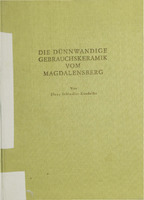Die dünnwandige Gebrauchskeramik vom Magdalensberg
Archäologische Forschungen zu den Grabungen auf dem Magdalensberg 3. Kärntner Museumsschriften 58
Author(s)
Schindler-Kaudelka, Eleny
Collection
Austrian Science Fund (FWF)Language
GermanAbstract
Excavations on the Magdalensberg in Carinthia, Southern Austria brought to light a large number of thinwalled pottery, Feinware, pareti sottili, parois fines, paredes finas. The finds from the 1948-1970 excavations mostly imported drinking vessels from Northern Italy are studied in a typological and chronological order. First a chapter sets the chronological frame offered by reliable dating complexes. To accomplish this, 30 contexts are examined and divided into a 3 period 7 phase system. The short life of the site from 50 BC to 50 AD permits a dating range of less than 20 years for most of the shapes. Typological classification of the roughly 150 shapes present is based on the distinction of 10 different fabric groups. Quantification studies, reflections on provenience, intended use and production techniques round up the research. Two supplement papers of 1998 and 2012 take into account the state of the art.
SCHINDLER-KAUDELKA, E., mit Unterstützung von SCHNEIDER, G., Die dünnwandige Gebrauchskeramik vom Magdalensberg 2. – G. PICCOTTINI (Hg), Die Ausgrabungen auf dem Magdalensberg 1980 bis 1986. Magdalensberg-Grabungsbericht 16 (Klagenfurt 1998),
389–427.
SCHINDLER-KAUDELKA, E., La ceramica a pareti sottili del Magdalensberg 1975-1998-2011, - Emona between Aquileia and Pannonia, I. Lazar, B. Zupanek Ed., (Piran 2012), 323-366. Die Ausgrabungen auf dem Magdalensberg in Kärnten haben eine große Zahl an dünnwandigen – Feinware, thinwalled, pareti sottili, parois fines, paredes finas – Gefäßresten zutage gebracht. Das größtenteils aus Norditalien importierte Tischgeschirr wird anhand der Funde von 1948 bis 1970 typologisch und chronologisch geordnet vorgestellt. Zuerst wird der Periodisierungsrahmen datierender Komplexe als Grundlage der Datierungen besprochen. Dazu werden 30 Kontexte in 3 aufeinanderfolgenden Perioden, insgesamt 7 Phasen ausgewertet. Die kurze Belegdauer der Stadt auf dem Magdalensberg von circa 50 v. Chr. bis circa 50 n. Chr. erlaubt eine Feindatierung der meisten Funde auf knapp 20 Jahre. Die Sequenz von 10 Fabrikaten, innerhalb derer formal unterteilt wird, ergibt knapp 150 Formen. Vor der Besprechung der werden Gesamtzahlen werden weiterführende Überlegungen zu Herkunft, Verwendungszweck und Herstellungsverfahren angestellt. Zwei ergänzende Artikel spiegeln den heutigen Stand der Forschung wider.
SCHINDLER-KAUDELKA, E., mit Unterstützung von SCHNEIDER, G., Die dünnwandige Gebrauchskeramik vom Magdalensberg 2. – G. PICCOTTINI (Hg), Die Ausgrabungen auf dem Magdalensberg 1980 bis 1986. Magdalensberg-Grabungsbericht 16 (Klagenfurt 1998),
389–427.
SCHINDLER-KAUDELKA, E., La ceramica a pareti sottili del Magdalensberg 1975-1998-2011, - Emona between Aquileia and Pannonia, I. Lazar, B. Zupanek Ed., (Piran 2012), 323-366.


 Download
Download